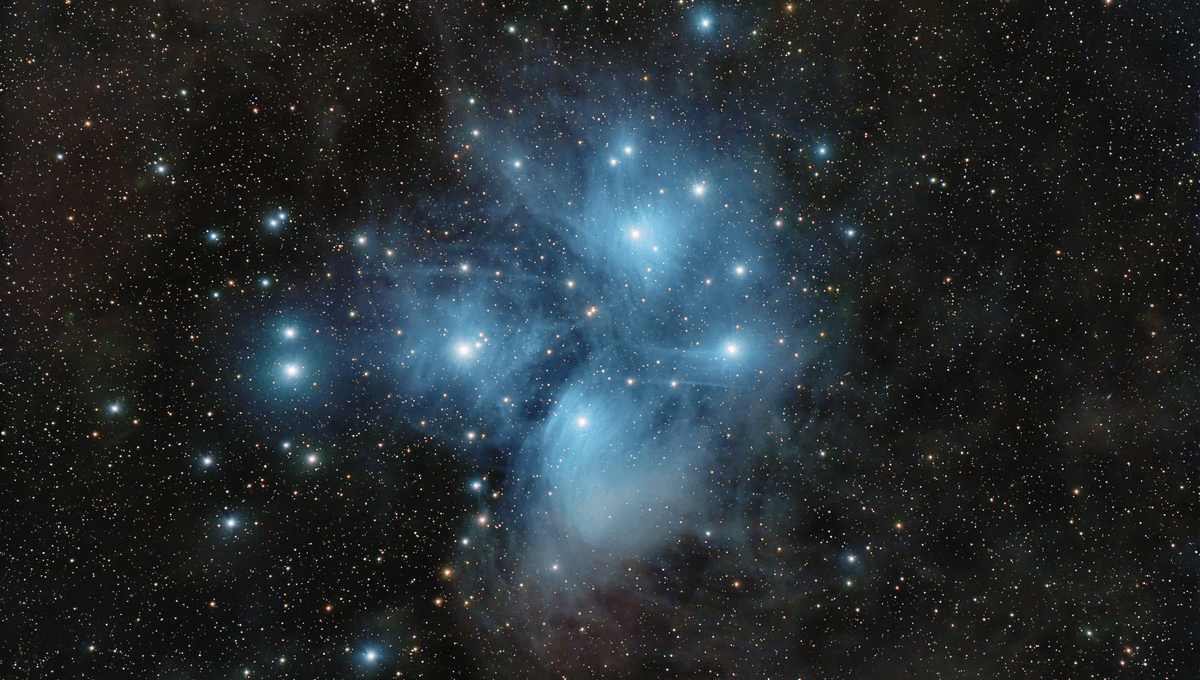
Look up at the night sky in the Northern Hemisphere from October to March, and (weather-permitting) you can catch a glimpse of Pleiades, also known as the Seven Sisters. As well as being an excellent example of an asterism (see also: the “Summer Triangle“), this cluster of stars serves as the inspiration for what could be the oldest story in the world.
The star cluster is in the constellation of Taurus, and is made up of over 1,000 stars, but the brightest of them all are hot blue luminous stars that formed around 100 million years ago.
These stars, like so many others, have myths attached to them by ancient cultures around the world. An intriguing aspect to this is how similar the stories are, and why the stories all mention seven sisters, when it is six stars that appear bright to the naked eye.
“In Greek mythology, the Seven Sisters are named after the Pleiades, who were the daughters of Atlas and Pleione. Their father, Atlas, was forced to hold up the sky, and was therefore unable to protect his daughters. But to save them from being raped by Orion the hunter, Zeus transformed them into stars,” a team that looked into the mystery wrote in a chapter of the 2021 book Advancing Cultural Astronomy.
Indigenous Australian versions of the tale, meanwhile, tell similar stories of a hunter or young man who try and chase the female Pleiades.
“The similarity between the Aboriginal and Greek stories of the Pleiades and Orion includes three specific elements: both identify the Pleiades as a group of young girls, both identify Orion as male, and both say that Orion is attempting to have sex with the girls in the Pleiades,” the book’s authors wrote.
The similarity between the two myths is intriguing, as there was almost no contact between European and indigenous Australian cultures from when their common ancestors left Africa around 100000 BCE until 1788 when the British invaded. Similar myths explaining that there are seven sisters but one is missing are found in African, Asian, Indonesian, and Native American cultures.
The team looked for an explanation as to why the myth involved a seventh bright star, visible to the naked eye. Running simulations, they found that 100,000 years ago, a seventh star – Pleione – would have been visible, but it is now too close to Atlas and so they look like a single star to the naked eye.
“When the Australians and Europeans were last together, in 100,000 [BCE], the Pleiades would have appeared as seven stars,” the team wrote in their book. “Given that both cultures refer to them as ‘Seven Sisters’, and that their stories about them are so similar, the evidence seems to support the hypothesis that the ‘Seven Sisters’ story predates the departure of the Australians and Europeans from Africa in 100,000 [BCE].”
There is other evidence for Indigenous Australian myths dating back a long, long time. One such myth told passed down by the Gunditjmara people of southern Australia involved a giant that bent down and turned into a mountain, before spewing molten rock from his mouth. This was of course thought to be telling the story of a volcanic eruption. In 2020, a team of researchers dated the lava produced by the volcano thought to be the inspiration behind it, and found that it erupted 37,000 years ago.
Unfortunately with both myths, we will likely never know for sure, but the evidence is intriguing nonetheless.
“Is it possible the stories of the Seven Sisters and Orion are so old our ancestors were telling these stories to each other around campfires in Africa, 100,000 years ago?” the team behind the Seven Sisters research concluded in a piece in The Conversation. “Could this be the oldest story in the world?”
An earlier version of this article was published in February 2024.
Source Link: Is This The World’s Oldest Story? Ancient Human Tale About The Seven Sisters May Be From 100,000 BCE